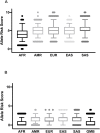Differences in the frequency of genetic variants associated with iron imbalance among global populations
- PMID: 32609760
- PMCID: PMC7329092
- DOI: 10.1371/journal.pone.0235141
Differences in the frequency of genetic variants associated with iron imbalance among global populations
Abstract
Iron deficiency anaemia is a major health problem affecting approximately 1.2 billion people worldwide. Young children, women of reproductive age and pregnant women living in sub-Saharan Africa are the most vulnerable. It is estimated that iron deficiency accounts for half of anaemia cases. Apart from nutritional deficiency, infection, inflammation and genetic factors are the major drivers of anaemia. However, the role of genetic risk factors has not been thoroughly investigated. This is particularly relevant in African populations, as they carry high genetic diversity and have a high prevalence of anaemia. Multiple genetic variations in iron regulatory genes have been linked to impaired iron status. Here we conducted a literature review to identify genetic variants associated with iron imbalance among global populations. We compare their allele frequencies and risk scores and we investigated population-specific selection among populations of varying geographic origin using data from the Keneba Biobank representing individuals in rural Gambia and the 1000 Genomes Project. We identified a significant lack of data on the genetic determinants of iron status in sub-Saharan Africa. Most of the studies on genetic determinants of iron status have been conducted in Europeans. Also, we identified population differences in allele frequencies in candidate putative genetic risk factors. Given the disproportionately high genetic diversity in African populations coupled with their high prevalence of iron deficiency, there is need to investigate the genetic influences of low iron status in Sub-Saharan Africa. The resulting insights may inform the future implementation of iron intervention strategies.
Conflict of interest statement
The authors have declared that no competing interests exist.
Figures









References
-
- WHO. Global Burden of Disease Study 2017. Lancet. 2017; 1–7.
Publication types
MeSH terms
Grants and funding
- MC-A760-5QX00/MRC_/Medical Research Council/United Kingdom
- BB/R013063/1/BB_/Biotechnology and Biological Sciences Research Council/United Kingdom
- MC_PC_MR/R020183/1/MRC_/Medical Research Council/United Kingdom
- MC_U123292699/MRC_/Medical Research Council/United Kingdom
- MR/R020973/1/MRC_/Medical Research Council/United Kingdom
LinkOut - more resources
Full Text Sources

